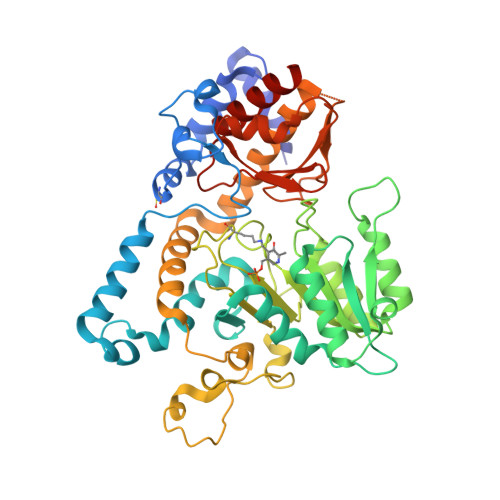Bypassing evolutionary dead ends and switching the rate-limiting step of a human immunotherapeutic enzyme.
Blazeck, J., Karamitros, C.S., Ford, K., Somody, C., Qerqez, A., Murray, K., Burkholder, N.T., Marshall, N., Sivakumar, A., Lu, W.C., Tan, B., Lamb, C., Tanno, Y., Siddiqui, M.Y., Ashoura, N., Coma, S., Zhang, X.M., McGovern, K., Kumada, Y., Zhang, Y.J., Manfredi, M., Johnson, K.A., D'Arcy, S., Stone, E., Georgiou, G.(2022) Nat Catal 5: 952-967
- PubMed: 36465553
- DOI: https://doi.org/10.1038/s41929-022-00856-6
- Primary Citation of Related Structures:
7S3V - PubMed Abstract:
The Trp metabolite kynurenine (KYN) accumulates in numerous solid tumours and mediates potent immunosuppression. Bacterial kynureninases (KYNases), which preferentially degrade kynurenine, can relieve immunosuppression in multiple cancer models, but immunogenicity concerns preclude their clinical use, while the human enzyme (HsKYNase) has very low activity for kynurenine and shows no therapeutic effect. Using fitness selections, we evolved a HsKYNase variant with 27-fold higher activity, beyond which exploration of >30 evolutionary trajectories involving the interrogation of >10 9 variants led to no further improvements. Introduction of two amino acid substitutions conserved in bacterial KYNases reduced enzyme fitness but potentiated rapid evolution of variants with ~500-fold improved activity and reversed substrate specificity, resulting in an enzyme capable of mediating strong anti-tumour effects in mice. Pre-steady-state kinetics revealed a switch in rate-determining step attributable to changes in both enzyme structure and conformational dynamics. Apart from its clinical significance, our work highlights how rationally designed substitutions can potentiate trajectories that overcome barriers in protein evolution.
- Department of Chemical Engineering, University of Texas at Austin (UT Austin), Austin, Texas, USA.
Organizational Affiliation:


















